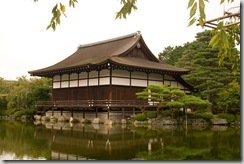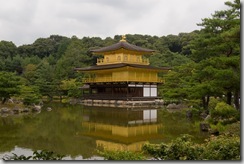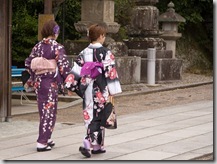With our hosts having to go to work for the day, we were left to our own devices, which mainly consisted of a guided bus tour of Kyoto. Due to the toilets at the bus station being located almost half a block away, we missed our scheduled bus by about a minute (curse that Japanese punctuality!), so with a cry of, "Follow that bus!", we grabbed a taxi and attempted to get to the first stop on the itinerary ahead of the bus. We were rather mindful of horror stories of how much Tokyo cabs cost, but fortunately our man came through, and we pulled up at the first shrine just as our fellow tourists were disembarking.
One thing that became immediately obvious was that we were the only foreigners on the tour, and also that no-one else spoke Japanese, the guide included. In some cases, this even included the various guide pamphlets, so there are some places that we have been to that we have absolutely no idea what their significance is.
 Heian-jingu was the first stop along the route, built in 1895 to commemorate the 1100th anniversary of the founding of the Kyoto. The buildings are reduced-size replicas of the Heian-period Imperial palace; the garden is also very photogenic, so we had a slightly-hurried wander around, not wanting to miss the bus onwards.
Heian-jingu was the first stop along the route, built in 1895 to commemorate the 1100th anniversary of the founding of the Kyoto. The buildings are reduced-size replicas of the Heian-period Imperial palace; the garden is also very photogenic, so we had a slightly-hurried wander around, not wanting to miss the bus onwards.
Our next stop was Togetsukyo Bridge. Unfortunately, the language barrier meant that we had no idea what we were looking at, or why we were looking at it! This also meant that I didn't take any photos of it, since at this time of year it's just a bridge. Later on we Googled it to work out what we missed - apparently it's good for viewing the cherry blossom in spring and the autumn leaves in, um, autumn - shame we missed both! On the plus side, we did get to eat unagi, although again we had no idea what it was at the time.
 After lunch, we headed for probably the most visually spectacular shrine, at Kinkaku-ji, the Golden Temple. This is a 20th century reconstruction of the the 14th century original (a rather obsessed monk burned it down in 1950), and the gold leaf now covers the first floor as well as the second. The gardens were equally impressive, with a few more signs of trees turning colour with the autumn.
After lunch, we headed for probably the most visually spectacular shrine, at Kinkaku-ji, the Golden Temple. This is a 20th century reconstruction of the the 14th century original (a rather obsessed monk burned it down in 1950), and the gold leaf now covers the first floor as well as the second. The gardens were equally impressive, with a few more signs of trees turning colour with the autumn.
 Kiyomizu-dera required a bit more hard work to reach, climbing up the hillside along a street lined with touristy-type shops. It was obviously a favourite destination for school trips, as there were several busloads of uniformed children, many of them tying prayers to the prayer fences. There were also a good number of women wearing kimonos about. Feeling a bit worn out from all the hard slogging, we sat down for some mat-cha, the formal whisked green tea, along with some sticky sweet rice balls filled with red bean paste, then back down the hill and on to our bus to return home.
Kiyomizu-dera required a bit more hard work to reach, climbing up the hillside along a street lined with touristy-type shops. It was obviously a favourite destination for school trips, as there were several busloads of uniformed children, many of them tying prayers to the prayer fences. There were also a good number of women wearing kimonos about. Feeling a bit worn out from all the hard slogging, we sat down for some mat-cha, the formal whisked green tea, along with some sticky sweet rice balls filled with red bean paste, then back down the hill and on to our bus to return home.
No comments:
Post a Comment